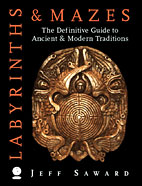This labyrinth typology reference has opened a new browser window. When you have completed your research, simply close the browser window and you will be returned to the Labyrinth Locator.
Preface | Typology | Classical | Roman | Medieval | Contemporary | Mazes | Other
An Introduction to Labyrinth Typology
By Jeff Saward, editor of Caerdroia — the Journal of Mazes & Labyrinths.
In dealing with a subject as varied and complex as labyrinths and mazes, it is essential to make definitions that can be clearly explained. The first task is to clarify the difference between a labyrinth and a maze. While the terms are often used interchangeably, many historians and enthusiasts are passionate about which is which. Look up the words in a good dictionary and you will probably conclude that a maze is a labyrinth and a labyrinth is a maze. However, in the English-speaking world it is often considered that to qualify as a maze, a design must have choices in the pathway. Clearly, this multicursal category will include many of the modern installations in entertainment parks and tourist attractions, which exist solely for the purpose of perplexing visitors, as well as the traditional hedge mazes in public parks and private gardens around the world.
Popular consensus also indicates that labyrinths have one pathway that leads inexorably from the entrance to the goal, albeit by the most complex and winding of routes. These unicursal designs have been known as labyrinths for thousands of years, and to qualify as a labyrinth, a design should have but one path. However, the dividing line between what constitutes a maze or a labyrinth can sometimes become blurred, as mazes with single paths and labyrinths with more than one path can exist, although their intent is usually clear from their designs.
While this debate is easily resolved, much more heated discussion has surrounded attempts to establish a system of classification for different types of labyrinths and mazes. During the last fifty years various systems have been proposed to define the individual forms of labyrinths and mazes. They are often over-complicated and confusing to the general reader. The system used in the WWLL relies largely on structural differences and is classified according to cultural and developmental origins.
 The text and illustrations below are © Jeff Saward 2003 (unless stated otherwise), adapted and reproduced with permission, from Jeff's study of historical labyrinths and mazes, published in the UK as Labyrinths & Mazes: The Definitive Guide to Ancient & Modern Traditions by Gaia Books, London, 2003 (ISBN 1-85675-183-X); in the USA by Lark Books, New York, 2003 as Labyrinths & Mazes: A Complete Guide to Magical Paths of the World (ISBN 1-57990-539-0); in Germany by AT Verlag, Aarau & Munich, 2003 as Das Große Buch der Labyrinthe und Irrgärten (ISBN 3-85502-921-0) and in Russia by Ниопа 21-й век, Moscow, 2005 as ЛБИРИНТЫ (ISBN 5-322-00291-X).
The text and illustrations below are © Jeff Saward 2003 (unless stated otherwise), adapted and reproduced with permission, from Jeff's study of historical labyrinths and mazes, published in the UK as Labyrinths & Mazes: The Definitive Guide to Ancient & Modern Traditions by Gaia Books, London, 2003 (ISBN 1-85675-183-X); in the USA by Lark Books, New York, 2003 as Labyrinths & Mazes: A Complete Guide to Magical Paths of the World (ISBN 1-57990-539-0); in Germany by AT Verlag, Aarau & Munich, 2003 as Das Große Buch der Labyrinthe und Irrgärten (ISBN 3-85502-921-0) and in Russia by Ниопа 21-й век, Moscow, 2005 as ЛБИРИНТЫ (ISBN 5-322-00291-X).